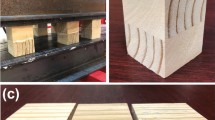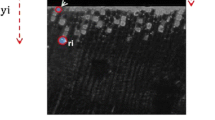Abstract
The extended use of woods treated with traditional or alternative preservatives for exterior applications requires an assessment of wood adhesive performance. This study attempts to evaluate the performance of wood adhesives for woods treated with various waterborne preservatives. Two softwood species, i.e. Korean pine (Pinus koraiensis Sieb. et Zucc.) and Japanese Larch (Larix leptolepis [Sieb. et Zucc.] Gordon) were treated with copper–chrome–arsenic (CCA), CB-HDO, or copper azole (CY), and then bonded with four different wood adhesives such as urea–melamine–formaldehyde (UMF) resin, melamine–formaldehyde (MF) resin, phenol–formaldehyde (PF) resin, and resorcinol–formaldehyde (RF) resin. The performance of these adhesives was evaluated by measuring the dry shear strength of adhesive-bonded wood block on compression. Both UMF and MF resins produced a relatively strong adhesive strength for CY-treated pine and larch woods. The PF resin also produced good bond strength when bonded with either larch wood treated with CY or pinewood treated with CB-HDO. The best result was obtained when the CB-HDO-treated woods were bonded with RF resin. For a better bond strength development, a proper combination of adhesive, preservative, and wood species should be selected by taking into consideration of the characteristics of these three parameters as well as their interactions.

Similar content being viewed by others
References
ASTM D 905 (1994) Standard test method for strength properties of adhesive bonds in shear by compression loading. ASTM, Philadelphia
Chen TY, Paulitsch M (1974) The extractives of needles, bark and wood of pine and spruce and their effect on particleboard made thereof. Holz Roh- Werkst 32(10):397–401
Clausen CA, Kartal SN, Muehl J (2001) Strength and durability of phenol-resorcinol joints of CCA-treated and untreated southern pine. For Prod J 51(7/8):61–64
Hong JZ, Gardner DJ, Wang JZ, Shi Q (1997) Surface tension, adhesive wettability, and bondability of artificially weathered CCA-treated southern pine. For Prod J 47(10):69–72
Johns WE, Niazi KA (1981) Effect of pH and buffering capacity of wood on the gelation time of urea–formaldehyde resin. Wood Fiber Sci 2(4):255–263
Junko M, Takato N, Yasushi H, Masanori K (1999) Effects of wood preservatives on adhesive properties of phenol–resorcinol–formaldehyde resin. Mokuzai Gakkaishi 45(1):34–41
Junko M, Takato N (2002a) Effects of wood preservatives on adhesive properties II; curing reaction of resorcinol–formaldehyde resin with Cu. Mokuzai Gakkaishi 48(3):178–183
Junko M, Takato N (2002b) Effects of wood preservatives on adhesive properties III; curing of aqueous vinyl polymer solution-isocyanate adhesive with preservatives. Mokuzai Gakkaishi 48(3):184–190
Junko M, Takato N (2003) Effects of wood preservatives on adhesive properties IV; effects of preservation and incising on shear strength and delamination. Mokuzai Gakkaishi 49(3):212–219
Kang SM, Kim GH, Paik KH (1995) Treatment characteristics of Japanese larch heartwood with CCA or CCFZ and improving its CCA treatability by incising techniques. J Korean Wood Sci Technol 23(4):60–66
Lebow ST, Foster DO, Lebow PK (1999) Release of copper, chromium, and arsenic from treated southern pine exposed in seawater and freshwater. For Prod J 49(7/8):80–89
Li W, Shupe TF, Hse CY (2004) Physical and mechanical properties of flakeboard produced from recycled CCA-treated wood. For Prod J 54(2):89–94
Mcnamara WS, Sullivan CE, Higgins JC (1970) pH measurements on northeastern woods. Wood Sci 3(1):48–51
Mengeloglu F, Gardner DJ (2000) Recycled CCA-treated lumber in flakeboards: evaluation of adhesives and flakes. For Prod J 50(2):41–45
Meyer B (1979) Urea–formaldehyde resins. Addison-Wesley, London, pp 22–96
Munson JM, Kamdem DP (1998) Reconstituted particleboards from CCA-treated red pine utility poles. For Prod J 48(3):55–62
Park BD, Riedl B (2000) 13C-NMR study on cure-accelerated phenol–formaldehyde resins with carbonates. J Appl Polym Sci 77(4):841–851
Pizzi A (1979) Phenolic and tannin-based adhesive resins by reactions of coordinated metal ligands. I. Phenolic chelates. J Appl Polym Sci 24:1247–1255
Pizzi A (1994) Advanced wood adhesive technology. Marcel Dekker, New York, pp 1–18
Sellers T, Miller GD (1997) Evaluations of three adhesive systems for CCA-treated lumber. For Prod J 47(10):73–76
Subramanian RV, Somasekharan KN, Johns WE (1983) Acidity of wood. Holzforschung 37:117–120
Vick CB (1980) Structural bonding of CCA-treated wood for foundation systems. For Prod J 30(9):25–32
Vick CB (1995) Coupling agent improves durability of PRF bonds to CCA-treated southern pine. For Prod J 45(3):78–84
Vick CB, Geimer RL, Wood JE (1996) Flakeboards from recycled CCA-treated southern pine lumber. For Prod J 46(11/12):89–91
Vick CB (1997) Enhanced adhesion of melamine-urea and melamine adhesives to CCA-treated southern pine lumber. For Prod J 47(7/8):83–87
Vick CB (1994) Preliminary finding on adhesive bonding of CCA-treated southern pine. Adhesive and Bonded Wood Prod, pp 158–176
Vick CB, Christiansen AW (1993) Cure of phenol–formaldehyde adhesive in the presence of CCA-treated wood by differential scanning calorimetry. For Prod J 25(1):77–86
Vick CB, Kuster TA (1992) Mechanical interlocking of adhesive bonds to CCA-treated southern pine: a scanning electron microscopic study. Wood Fiber Sci 24(1):36–46
Wang JZ, DeGroot R (1996) Treatability and durability of heartwood, Gen. Tech. Report FPL-GTR-94. Forest Products Lab., Madison, WI, USA. pp 252–260
Zhang HJ, Gardner DJ, Wang JZ, Shi Q (1997) Surface tension, adhesive, wettability, and bondability of artificially weathered CCA-treated southern pine. For Prod J 47(10):69–72
Author information
Authors and Affiliations
Corresponding author
Rights and permissions
About this article
Cite this article
Lee, Dh., Lee, M.J., Son, DW. et al. Adhesive performance of woods treated with alternative preservatives. Wood Sci Technol 40, 228–236 (2006). https://doi.org/10.1007/s00226-005-0036-7
Received:
Published:
Issue Date:
DOI: https://doi.org/10.1007/s00226-005-0036-7




